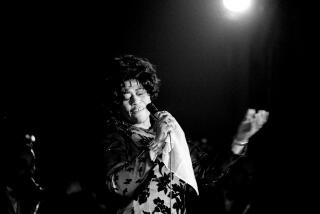Niemack’s Strong Singing, Weak Storytelling
- Share via
Effective jazz singing demands a number of seemingly incompatible skills. There is, first of all, the need to essentially perform like a musical instrument, moving through melodies in an improvisational fashion, interacting with the harmonies and generating an inner sense of swing.
At the same time, however, there is the need to respect the song and its message and to find a balance between the musical and the storytelling aspects of a performance.
Few singers fully accomplish both of these difficult tasks, which may be why the list of legendary jazz vocalist icons is such a short one.
Judy Niemack, a Pasadena-born singer who lives in Germany, for years has been making a determined--if not highly visible--effort to achieve her own method of integrating these various elements. On Monday, in a rare one-night appearance at the Jazz Bakery, she revealed the strengths as well as some of the weaknesses in her quest.
What became immediately apparent was that Niemack is an extraordinarily sophisticated musician. Much of her performance, in fact, might better be described as that of a vocal instrumentalist rather than a pure singer.
On pieces such as Monk’s “Misterioso,” for example, she navigated the disjunct melody without accompaniment. On Lee Konitz’s “Kary’s Trance,” she whipped through the complex line, alternating unison and harmony passages with alto saxophonist Gary Foster. Other tunes positioned her voice--sometimes with Foster, sometimes with the guitar of Jean-Francois Prins--in a distinctly instrumental context. In virtually every case, her singing was filled with rhythmic propulsiveness.
But Niemack was considerably less effective with the storytelling aspects of her task. Despite her vocal virtuosity, her sound emerged within a limited tonal spectrum. Light and airy, it lacked the timbral intensity required for some of the darker-messaged tunes she sang. Nor did her much-heralded scat singing skills reach the high bar established by artists such as Ella Fitzgerald and Mel Torme. Most of Niemack’s scatting was associated with repetitious vamps rather than more difficult chordal schemes--well done, for what it was, but limited. It was, like the balance of her performance, the work of a gifted singer still in search of a fully integrated musical expression.
Bassist Putter Smith and drummer Joe LaBarbera were particularly compatible musical associates, playing Niemack’s carefully crafted arrangements with their usual skill and subtlety.
More to Read
The biggest entertainment stories
Get our big stories about Hollywood, film, television, music, arts, culture and more right in your inbox as soon as they publish.
You may occasionally receive promotional content from the Los Angeles Times.










